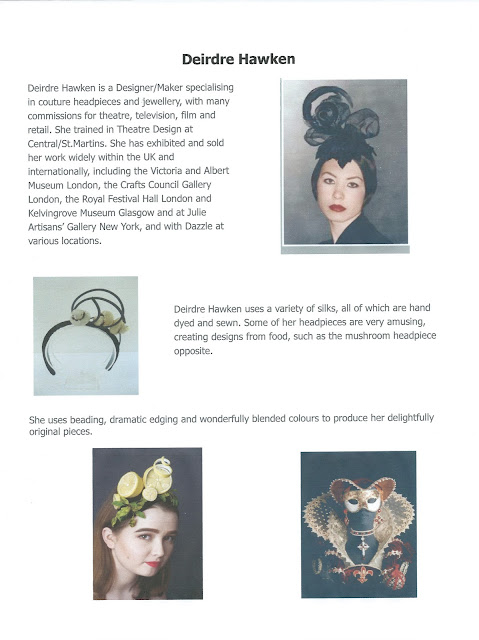EVALUATION
OF FUNCTIONAL 3D EMBROIDERED ITEM
The completed embroidered assessment
piece for Module Three
is a pair of Beach Anklets
based on the design topic of my grandson's ear!
How do you feel
about the resulting conclusion?
I was very pleased
with the result. Having drawn the ear and then created it in
cardboard, I could see the potential for using the intertwining
curves. It led me on to looking at coral and marine life. I used cord
making and bead work to create the 'reef' and plaiting to secure the
anklets in place. It was good to work in colour again and I loved the
combination of orange and turquoise. I am glad I chose silk for the
upper part of the anklet as it gives the 'sea' a lovely shimmer.
Although the anklets are quite an unusual accessory to own, I think I
will get good use out of them next summer.
Is it fit for
purpose - give reasons?
I had to make sure
that the elastic cords were tight enough to hold the anklet in place
but not too tight so that I could not get them on. By slipping my
foot through the ankle plait, there was enough stretch left for me to
loop the 3 strand plait over my toe. The felt made the anklet
slightly thicker than I would have liked but it was necessary to have
a good base to stitch the embroidery on to. This meant that the left
and right edges of the anklet did not have a great deal of curve over
my instep. I sprayed a little fabric stiffener on the underside of
the anklets and dried them over a tube. This gave them the right
shape but did not alter the overall feel of the back of the anklet.
When I wear them, they stay in place and look very decorative.
If you were
asked to make it again, what changes would you make to the way you
designed it an the way you made it?
Having stitched
them with a felt lining, I would probably try to use a finer
supporting fabric so that I would not have had the need to apply
fabric stiffener to re-shape them. I would also have cut the
underside fabric on the bias so that it would have curved without
showing any wrinkles.
Timings,
Costs and Health and Safety Log
TIMING
Date
when design work was started 23/08/17 Completed 30/09/17
Date
when embroidered item was started 16/10/17 Completed 31/10/17
Total
of whole hours recorded in diary 198
Total
number of hours spent working on design work 15
Total
number of hours spent working on embroidery 20
Analysis
Date
Completed
|
Chapter
|
Materials Used
|
Hours
|
Cost £
|
Health and
safety
|
| 07/05/17 |
1
|
Paper, printer ink, glue stick |
16
|
3
|
Use of scissors, guillotine, glue stick |
| 16/05/17 |
2
|
As above, card, tissue paper, corregated paper, modelling clay, brusho inks, acrylic paint, PVA glue, glue stick |
18
|
2
|
As above, use of craft knife, PVA glue |
| 22/05/17 |
3
|
Cold water dyes, salt, acrylic paints, fabric medium, beads and shells, glue stick, fabric |
10
|
10
|
Cold water dyes, use of craft knife |
| 07/06/17 |
4
|
Dyed fabric, thread |
33
|
1
|
Free machining, use of needle |
| 22/06/17 |
5
|
String, thread, wire, wool |
7.5
|
1
|
Free machining, use of needle |
| 26/06/17 |
6
|
Thread, beads, |
5
|
2
|
Needle, cord winder |
| 31/07/17 |
7
|
Polystyrene, thread, string, metal hoops, tyvek, acrylic paint, feathers |
12
|
2
|
Craft knife, heat gun, soldering iron, needle |
| 27/07/17 |
8
|
Beads, shisha mirror, sequins, net, thread, tyvek |
34
|
3
|
Needle |
| 22/08/17 |
9
|
Dyed fabric, cords, tyvek, beads, polystyrene, beads, padding |
22.5
|
3
|
Free machining, heat gun |
| 30/09/17 |
10
|
Dyed silk, wire, bondaweb, soluble fabric, acrylic paint, elastic cord |
15
|
2
|
Free machining, |
| 31/10/17 |
11
|
Dyed silk, cord, shells, emb. thread, thread, felt, dyed cotton, elastic cord, fabric stiffener |
20
|
7
|
Free machining, needle |
| 02/11/17 |
12
|
Paper |
5
|
-
|
Guillotine |
| TOTALS |
198
|
36
|
STORAGE
OF WORK, MATERIALS, TOOLS AND EQUIPMENT
| ITEM | STORAGE |
| Design work in progress | In sealed plastic container, away for light, dust |
| Completed embroidery | Wrap in acid free tissue paper |
| Completed design work | In sketchbook |
| Papers for design work | In sealed plastic container etc |
| Inks, dyes and paints | Upright in cupboard |
| Glue, sprays | As above |
| Embroidery work in progress | In sealed plastic container etc |
| Fabrics | In sealed plastic container etc |
| Threads | Laid out in drawers |
| Beads | In sealed plastic containers etc |
| Sewing machine | Upright, covered at night |
| Electrical equipment | Stored neatly in cupboard |
HEALTH
AND SAFETY
| Soldering iron | Hold at correct angle, mount in upturned flowerpot, use glass to protect work surface. Well ventilated room. Store away from children and pets. |
| Heat gun | Hold at correct angle, use insulating board/fabric to protect work surface. Well ventilated room. Store away from children and pets. |
| Dyes | Wear protective clothing. Work in well ventilated room. Store away from children and pets. |
| Guillotine | Store away from children, do not allow build up of paper shreds. |


























































